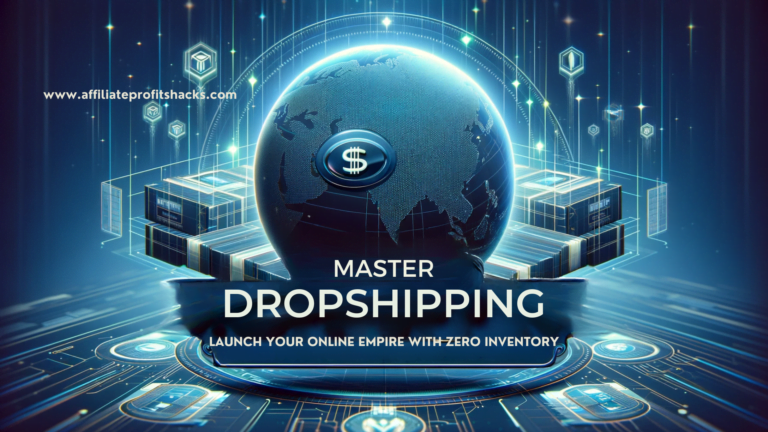E-commerce Stores Unveiled: A Guide to Online Success
Welcome to my article about building a successful E-commerce store.
E-commerce has revolutionized the way we shop and sell. It allows businesses to reach customers worldwide, 24/7, from the comfort of their homes or on the go. Starting an e-commerce store can seem daunting, but with the right approach, it becomes manageable and rewarding.
E-commerce, or electronic commerce, is buying and selling goods or services using the internet. It also involves transferring money and data to execute these transactions. This digital marketplace has grown rapidly, offering vast opportunities for entrepreneurs.
Best Recommended and Proven Way to Make Money Online – Click HERE for Instant ACCESS >>

The Benefits of Going Online
Going online has several advantages for businesses. It opens up a global market, reduces operational costs, and allows for personalized marketing strategies. Additionally, e-commerce platforms can handle a wide range of products and services, making it easier for businesses to expand their offerings.
Choosing the Right Platform
Selecting the right e-commerce platform is crucial. Options range from hosted solutions like Shopify and BigCommerce to self-hosted platforms like WooCommerce and Magento. Consider your business needs, budget, and technical skills when choosing.
Planning Your E-commerce Strategy
A solid e-commerce strategy involves understanding your target audience, deciding on the products or services to sell, and planning how to market your store. It’s important to research your competition and set clear, achievable goals for your business.
Key Takeaways
- E-commerce offers opportunities to reach a global audience.
- Choosing the right platform depends on your needs and capabilities.
- A well-planned strategy is essential for success.
Now that we’ve covered the fundamentals of getting started with e-commerce, it’s clear that while the journey requires effort, the potential rewards are significant. Moving forward, the next steps involve setting up your store, selecting products, and developing a marketing plan to ensure your e-commerce venture thrives.
Setting Up Shop: Your Online Store Launchpad
Creating your e-commerce store is an exciting step towards building your online business. This process involves several key actions, from choosing your store’s name to launching your website. Let’s dive into the steps to set up your shop effectively.
Selecting a Store Name and Domain
Your store’s name is the first thing customers will notice. It should be memorable, easy to spell, and reflect your brand. Once you’ve chosen a name, you’ll need to register a domain. This is your website’s address on the internet, like “www.yourstorename.com.” Check if your desired domain is available and register it through a domain registrar.
Choosing an E-commerce Platform
The platform you choose will be the backbone of your online store. It’s where you’ll design your website, add products, and manage orders. Each platform has its pros and cons, so consider what features are most important for your business. Some popular options include Shopify for its user-friendly interface and WooCommerce for its flexibility with WordPress sites.
Designing Your Store
Design plays a crucial role in attracting and retaining customers. Your store’s design should be clean, easy to navigate, and mobile-friendly. Many e-commerce platforms offer customizable templates, which you can use to create a professional-looking store without needing to know how to code.
If you’re not comfortable designing your store yourself, don’t worry. Fiverr has plenty of experts who specialize in every aspect of creating an e-commerce store. Whether it’s SEO or design, they’ve got you covered.
Setting Up Payment and Shipping
To sell online, you’ll need to set up payment gateways. These are services that process payments from your customers. Options include PayPal, Stripe, and Square. You’ll also need to decide on your shipping strategies. Will you offer free shipping, flat-rate shipping, or calculate shipping based on weight or destination?
Adding Products and Content
With the technical setup out of the way, it’s time to add your products. Include high-quality images, detailed descriptions, and pricing for each item. Also, create content for your site’s key pages, such as the “About Us” and “Contact” pages. This content should tell your brand’s story and provide customers with all the information they need to reach out to you.
Testing and Launching Your Store
Before going live, test your store thoroughly. Check that all links work, the checkout process is smooth, and the site looks good on both desktop and mobile devices. Once you’re confident everything works as it should, it’s time to launch your store.
Key Takeaways
- A memorable name and domain are crucial for your store’s identity.
- Select an e-commerce platform that fits your business needs.
- Design your store to be attractive and user-friendly.
- Set up payment gateways and decide on your shipping strategy.
- Add products and essential content to your site.
- Test your store before officially launching it.
Setting up your e-commerce store is a step-by-step process that lays the foundation for your online business’s success. With careful planning and attention to detail, you can create an online store that attracts customers and generates sales.
Products & Inventory: Selection and Management Tactics
Choosing the right products and managing your inventory efficiently is key to the success of your e-commerce store. This part of your business requires careful planning and ongoing management to meet customer demand without overstocking.
Understanding Your Market
Before selecting your products, it’s crucial to understand your target market. Who are your potential customers? What do they need or want? Researching market trends, customer reviews, and competitor offerings can provide valuable insights. This knowledge helps you choose products that will appeal to your target audience.
Selecting Your Products
When deciding on your product range, consider factors such as profit margins, shipping costs, and supplier reliability. It’s often a good idea to start with a smaller selection of products to manage your inventory and costs effectively. Over time, you can expand your offerings based on customer feedback and sales data.
Best Recommended and Proven Way to Make Money Online – Click HERE for Instant ACCESS >>
Managing Inventory
Inventory management is about having the right products in the right quantity on hand, avoiding excess stock and out-of-stocks. Use inventory management software to track your stock levels, sales patterns, and reorder points. This technology can help you make informed decisions about when to reorder products or adjust your stock levels.
Dealing with Suppliers
Building good relationships with your suppliers is essential. They should be reliable, offer quality products, and have reasonable shipping times. Negotiate terms that benefit your business, such as discounts for bulk purchases or better payment terms. Always have a backup plan in case a supplier runs into problems.
Pricing Your Products
Setting the right price for your products is a balance between being competitive and making a profit. Consider your costs, including purchase price, shipping, taxes, and your e-commerce platform fees. Then, look at your competitors’ prices. You may not always want to be the cheapest, but your prices should reflect the value you offer.
Key Takeaways
- Know your target market to select appealing products.
- Start with a manageable product range and expand based on demand.
- Use inventory management software to maintain optimal stock levels.
- Establish strong relationships with reliable suppliers.
- Price your products competitively, considering all costs.
Selecting and managing your products and inventory wisely can significantly impact your e-commerce store’s success. It’s about offering what your customers want at the right price and ensuring you can deliver it efficiently and reliably.
Amplify Your Reach: Key Marketing Moves
Marketing your e-commerce store effectively is crucial for attracting customers and driving sales. With so many digital marketing tools and platforms available, it’s important to choose strategies that align with your business goals and target audience.
Understanding Digital Marketing
Digital marketing encompasses all marketing efforts that use an electronic device or the internet. Businesses leverage digital channels such as search engines, social media, email, and other websites to connect with current and prospective customers. The goal is to promote your brand, products, and services online.
Leveraging Social Media
Social media platforms like Facebook, Instagram, and Twitter are powerful tools for e-commerce marketing. They allow you to engage with your audience, share content about your products, and drive traffic to your website. Create engaging posts, interact with followers, and use paid advertising options to broaden your reach.
Mastering Search Engine Optimization (SEO)
SEO is the practice of optimizing your website to rank higher in search engine results for keywords related to your products or services. This involves optimizing your site’s content, structure, and on-page elements like titles, meta descriptions, and alt tags. SEO helps improve visibility and attract organic traffic to your site.
Email Marketing
Email marketing is a direct way to communicate with your customers. Use it to promote products, share news, or offer discounts. The key to successful email marketing is personalization. Segment your email list based on customer behavior or preferences to send targeted, relevant messages.
Creating Quality Content
Content marketing involves creating and distributing valuable, relevant, and consistent content to attract and retain a clearly defined audience. Blog posts, videos, infographics, and podcasts can help establish your brand as a thought leader in your industry. This content can also improve your site’s SEO and drive organic traffic.
Utilizing Paid Advertising
Paid advertising, such as Google Ads or Facebook Ads, can quickly increase your store’s visibility. These platforms allow you to target your advertising to specific demographics, interests, and behaviors, ensuring your message reaches the right audience.
Key Takeaways
- Use social media to engage with your audience and promote your products.
- Optimize your website for search engines to improve visibility.
- Personalize your email marketing campaigns for better engagement.
- Create valuable content to establish your brand and attract traffic.
- Invest in paid advertising for targeted reach and quick results.
By implementing these key marketing strategies, you can significantly enhance your e-commerce store’s online presence and customer base. Marketing is an ongoing process, so continue to test and adjust your strategies based on performance and feedback.
Business Growth: Strategies for Scaling
Scaling your e-commerce business involves expanding your operations to meet increased demand without compromising on quality or customer experience. It requires strategic planning and the implementation of systems that allow for growth. Here are key strategies to help scale your business effectively.
Evaluating Your Business Model
First, assess your current business model to identify strengths, weaknesses, opportunities, and threats. This evaluation will help you understand what aspects of your business are scalable and what areas may need adjustment. Consider factors such as your supply chain, customer service capabilities, and the scalability of your e-commerce platform.
Streamlining Operations
Efficiency is key to scaling. Investigate how to streamline operations, such as automating order processing, inventory management, and customer service tasks. This can free up time and resources to focus on growth activities. Also, consider outsourcing non-core tasks to specialists.
Expanding Your Product Line
Introducing new products or expanding into new markets can drive growth. However, ensure that any new products align with your brand and meet the needs of your target market. Conduct market research to validate demand before investing in product development.
Enhancing Customer Experience
As your business grows, maintaining a high level of customer service is vital. Invest in customer service tools and training for your team. Consider implementing a customer relationship management (CRM) system to manage customer interactions more efficiently.
Leveraging Data for Decision-Making
Use data analytics to make informed decisions about your business. Analyze sales data, customer feedback, and market trends to identify growth opportunities. Data can also help you optimize your marketing strategies and improve product offerings.
Financing Growth
Scaling often requires investment. Options include reinvesting profits, seeking a business loan, or finding investors. Choose a financing strategy that suits your business goals and financial situation. Be prepared with a solid business plan to present to potential lenders or investors.
Best Recommended and Proven Way to Make Money Online – Click HERE for Instant ACCESS >>
Key Takeaways
- Assess and adjust your business model for scalability.
- Streamline operations to improve efficiency and reduce costs.
- Consider expanding your product line or entering new markets.
- Prioritize customer experience to retain and attract customers.
- Use data analytics to guide your growth strategies.
- Explore financing options to support expansion efforts.
Scaling your e-commerce business is a challenging but rewarding process. By focusing on strategic planning, operational efficiency, and customer satisfaction, you can grow your business sustainably.
Keep Customers Coming Back: Engagement & Retention Secrets
Engaging with your customers and encouraging them to return to your e-commerce store is crucial for long-term success. Customer retention is more cost-effective than acquiring new customers and can significantly boost your revenue. Here are strategies to enhance customer engagement and keep them coming back.
Providing Excellent Customer Service
Outstanding customer service is the cornerstone of customer retention. Respond promptly to inquiries and resolve issues efficiently. Offering live chat support can enhance the shopping experience by providing immediate assistance.
Personalizing the Customer Experience
Personalization can make your customers feel valued and improve their shopping experience. Use data from past purchases and browsing behavior to recommend products and tailor marketing messages. Personalized emails, for instance, can increase open rates and drive repeat purchases.
Implementing Loyalty Programs
Loyalty programs reward customers for their repeat business, encouraging them to continue shopping with you. Consider offering points for purchases, which can be redeemed for discounts, special offers, or free products. This incentivizes purchases and fosters a sense of belonging among your customers.
Gathering and Acting on Feedback
Customer feedback is invaluable for improving your products and services. Regularly solicit feedback through surveys or after purchase. Act on this feedback to make necessary improvements and let your customers know their opinions matter.
Creating Engaging Content
Engaging content can keep your brand top of mind for customers. Share blog posts, videos, and social media content that educates, entertains, or informs your audience about your products and industry. This can help build a community around your brand and keep customers engaged between purchases.
Offering Exclusive Deals
Exclusive deals and promotions for returning customers can be a powerful incentive. Email newsletters are an effective way to inform customers about upcoming sales, new product launches, and exclusive offers. This not only drives sales but also makes customers feel appreciated.
Key Takeaways
- Excellent customer service is essential for retention.
- Personalize the shopping experience to make customers feel valued.
- Implement loyalty programs to reward repeat business.
- Act on customer feedback to continuously improve.
- Use content to engage and educate your audience.
- Offer exclusive deals to returning customers.
By focusing on engagement and retention, you can build a loyal customer base that supports your e-commerce store over the long term. These strategies encourage repeat business and help turn customers into brand advocates.
Stay Safe & Legal: E-commerce Compliance and Security
Operating an e-commerce store comes with the responsibility of ensuring the safety of your customers’ data and complying with legal standards. This involves protecting against cyber threats and understanding the laws that govern online business activities. Here’s how you can keep your e-commerce store safe and compliant.
Understanding E-commerce Regulations
Familiarize yourself with the regulations that apply to e-commerce businesses. This includes laws on consumer rights, data protection, and digital transactions. For instance, the General Data Protection Regulation (GDPR) affects how you collect and handle customer data in the European Union. Compliance is not just legal; it builds trust with your customers.
Implementing Secure Payment Gateways
Secure payment processing is essential to protect your customers’ financial information. Use reputable payment gateways that encrypt data during transactions. Additionally, ensure your site is PCI DSS compliant if you’re handling credit card information directly.
Protecting Against Cyber Threats
Cybersecurity measures are crucial to safeguard your store and customer data from threats like hacking and phishing attacks. Use strong passwords, keep your website’s software up to date, and install security plugins or extensions. Regularly back up your data to prevent loss in case of a security breach.
Privacy Policies and Terms of Service
Create clear and accessible privacy policies and terms of service for your website. These documents should outline how you collect, use, and protect customer data, as well as the terms under which you sell goods and services. Regularly review and update these documents to reflect changes in your business practices or legal requirements.
Educating Your Team
If you have employees, educate them about the importance of data security and legal compliance. This includes training on recognizing phishing emails, managing customer data securely, and understanding your store’s policies and procedures.
Key Takeaways
- Stay informed about e-commerce regulations and ensure compliance.
- Use secure payment gateways and maintain PCI DSS compliance.
- Implement cybersecurity measures to protect against online threats.
- Provide clear privacy policies and terms of service on your website.
- Educate your team on security and legal best practices.
Maintaining compliance and security is an ongoing process that requires vigilance and adaptation to new threats and regulations. By prioritizing these areas, you can protect your business and build a trustworthy relationship with your customers.
Conclusion: Launching Into E-commerce Success
Embarking on an e-commerce venture is a journey filled with opportunities and challenges. From understanding the fundamentals of e-commerce to ensuring your store’s security and compliance, each step is crucial for building a successful online business. As we’ve explored, starting with a solid foundation, selecting the right products, marketing effectively, engaging with customers, and scaling wisely are all key components of e-commerce success.
Best Recommended and Proven Way to Make Money Online – Click HERE for Instant ACCESS >>
Reflecting on Your Journey
Remember, the path to success involves continuous learning and adaptation. The digital marketplace is ever-evolving, and staying informed about trends, technologies, and customer preferences is essential. Embrace the journey, and be prepared to pivot your strategies as needed to meet the changing demands of the online world.
The Importance of Customer Focus
Throughout this guide, a recurring theme has been the importance of focusing on your customers. From personalizing their shopping experience to ensuring their data’s security, putting your customers first is paramount. Happy, satisfied customers are more likely to return and recommend your store to others, driving your business’s growth.
Looking Ahead
As you move forward, keep exploring new ways to enhance your e-commerce store. Whether it’s through introducing innovative products, adopting new marketing strategies, or leveraging data analytics for better decision-making, there are always opportunities to grow and improve.
Final Thoughts
Launching and growing an e-commerce store is no small feat, but with determination, creativity, and a customer-centric approach, it’s within reach. Use the insights and strategies outlined in this guide as a roadmap to navigate the complexities of the online marketplace. Here’s to your success in the exciting world of e-commerce!
Thank you for reading my article “E-commerce Stores Unveiled: A Guide to Online Success”. I hope you found it informative and helpful!
For more insights into e-commerce, take a look at this article: Shopify Alternatives: Unveiling the Top Competitors in 2024







